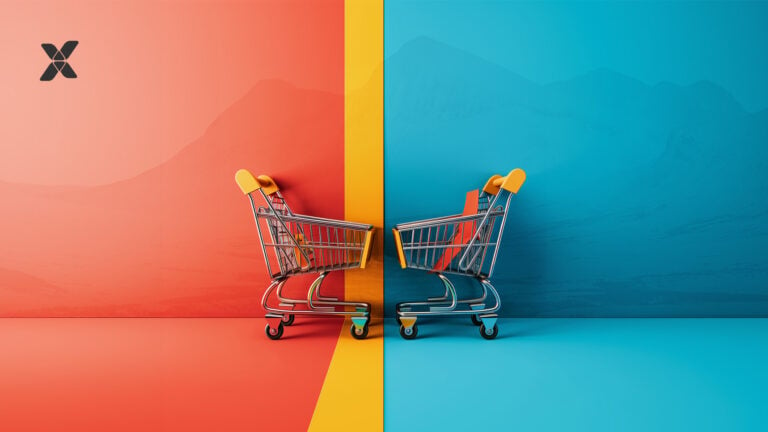When the pandemic hit, it forced a large portion of traditional retail to go online overnight. And during the past few years of Covid-imposed lockdowns, brands in all sectors have had to innovate and adapt to the drastically altered customer behaviors. But what happens next?
While it seems safe to say that most people will keep doing more shopping online than before the pandemic, both brands and consumers long to get back to a more normal way of life. And as brick-and-mortar shops are now open for business again, brands are doing what they can to bring their learnings into the physical world.
Related reading: Ecommerce Trends – 2022 Outlook
Phygital Experiences Expanding Consumer Choice
As ecommerce keeps growing stronger and stronger, many retail companies are exploring ways to merge their physical and digital offerings into phygital experiences. New technologies, from augmented reality and VR to QR codes, enable merchants to expand the IRL experiences by adding a virtual layer. This merging of the digital and physical is often referred to as phygital.
One way of doing this is through so-called endless aisles. An endless aisle is a virtual presentation of merchandise used to complement the physical inventory in a real-world store. So that when customers are walking the aisles of a store, they’re able to browse items that are not physically there.
The “endless aisles” add virtual merchandise that is not physically present – but still available for in-store purchase. You can shop from the shelves or pick from the virtual selection. This means customers will either leave the store with shopping bags or online tracking numbers, but they will not have to leave empty-handed.
Related reading: What Is a Phygital Experience – 6 Real-World Examples
New Technology Unlocking New Opportunities
In the wake of the covid pandemic, innovation in ecommerce and phygital technology has exploded. Today, retailers have access to a powerful arsenal of physical and digital tools to help them build a coherent customer experience that bridges the line between online and offline.
Through sales representatives, in-store kiosks, and AR technology, customers can get access to the entire product catalog instead of settling for whatever is in -stock within the walls of the physical store.
According to the Quarterly Retail Ecommerce Sales Q3 report from 2021, 87% of sales still come from Brick and Mortar. Adding a digital layer to physical shopping will be an essential next step for many retailers to meet consumer expectations and maximize sales.
Implementing endless aisles has numerous benefits, including fewer sales lost due to out-of-stock products, improved cross-selling and upselling, and increased brand engagement through exceptional, multichannel in-store service. When clients can access endless options, they don’t have to worry about not finding what they need. This feeling increases trust and loyalty and potentially reduces shipping costs and returns.
5 Benefits of Endless Aisles
1. Fewer lost sales
It’s common for customers to perform their research online but then head to the physical store when it comes to an actual purchase. In fact, 81% of shoppers conduct online product research before making an in-store purchase. This behavior can present a challenge for retailers, who are usually unable to maintain stock as extensive in the physical stores as they do online.
This is simply because physical stores come with limitations, whereas online shopping sites, on the other hand, are not limited by square footage and location. This means that customers often show up intending to buy something they’ve seen online, only to find it’s not available in the store. This creates a bad experience and often prompts customers to go elsewhere. By adding a digital layer to your physical store, you can showcase an unlimited number of products in a way that is easy for your customers to navigate.
2. Increased customer loyalty
Customers today expect a seamless, coherent, and pleasant buying journey, regardless of touchpoint or action. Providing the same experience and physical and online access to the same products creates continuity and builds trust. This makes customers feel they can rely on having a great experience, which builds loyalty.
3. Improved order fulfillment
One of the changes Covid brought is that consumers have grown to expect complete flexibility in every step of the buying journey. As businesses struggled to stay alive during the pandemic, many creative alternatives were invented. And now that we are no longer in lockdown, people will still want to keep the convenience they’ve become accustomed to.
Customers expect to be able to pay for and receive their purchases in the way that works for them. Whether that means to buy online and pick up in-store, to buy in-store and have the products delivered to their home, or to finalize purchases across other available channels, store fulfillment solutions make this possible. Endless aisle builds on this mindset of meeting their customers where they are, with anything they want.
4. Reduced shipping costs and fewer returns
Many people love the convenience of shopping from their couch, but doing so also comes with some challenges. However beautiful a jacket may look, it might not fit, and as ecommerce has exploded, so has returns and related shipping costs. The ability to try clothes on or speak with a salesperson about a product significantly reduces the likelihood of a return.
Therefore, combining shops or showrooms with endless aisles may often provide the best experience, the most satisfied customers, and the lowest number of returns. So much so that some brands, such as Bonobos, have even decided only to use this business model.
5. More revenue through cross-selling and upselling
When browsing a physical isle, customers only see what’s right there. But adding a digital layer with an endless aisle allows retailers to leverage technologies to recommend matching items, show how other customers often combine products and showcase the products in different settings. Introducing digital tools for “assisted sale” in the physical stores provide opportunities for cross-selling and upselling at a whole new level. While having a salesperson deliver all these messages would be intrusive, letting a chatbot recommend what items to add to the basket can dramatically affect the average sale size.
Endless Aisles: 5 Things To Keep In Mind
1. Pick the right technical platform
Choosing the right technology is an essential step on your way to combining physical stores with a digital inventory. Keeping your stock updated and accurate in real-time will be crucial for delivering a good customer experience. This requires a solid order management system (OMS) that reports across all sales channels.
Related reading: What is an Order Management System (OMS)
2. Ensure you have internal buy-in
Change is always a challenge, and introducing phygital experiences will require everyone in your organization to adapt their way of working. Processes will change, and new knowledge may be required. To achieve this, internal communication is essential. Your staff will also need easy access to all information, be able to monitor inventory levels, and communicate with individual customers. But, perhaps most importantly, they need to understand and buy into the concept of “assisted sales”. This often requires new compensation models to make sure associates get credit for the endless aisle sales.
3. Clear and correct communication is key
A crucial aspect of all digital sales is communication and customer support. Placing an order for something is just the first part of the customer experience; it’s what happens from there that will determine the level of your customer’s satisfaction. Keeping your customer continually informed about the status of their order is fundamental and will prevent a lot of potential frustration and questions. Unlike when products are purchased in-store, the customers shopping from your endless aisle will not be able to walk out with their purchases in a bag as they probably planned initially. Therefore it’s imperative to build trust in the delivery and make their wait as short as possible.
4. New types of content will be needed
Implementing endless aisles will involve creating new processes and developing new skills to enable your content team to cater to “phygital” customers. New types of content will be needed in this new age of retail – where brick-and-mortar stores increasingly merge with VR, AR, digital shelves, and endless aisles.
5. Consider in-store kiosks and mobile apps
Another significant leap in technology that we’ve seen during the pandemic is the transition many retailers have made from in-person service and checkouts to touchless payments through kiosk solutions or mobile apps. The benefits of these solutions are not only that they’re safer from a pandemic perspective, but they are also often a lot more convenient for the customers. Digital touch-screen technology and interactive displays allow people to purchase products at the point of inspiration, with just a few clicks, satisfying the ever-increasing need for instant gratification and improving the overall shopping experience.
How Vaimo Can Help
Endless aisles present retailers with exciting possibilities to show and promote their full digital catalog of products to customers visiting their physical stores. Consumers today expect seamless shopping experiences, regardless of when and where they decide to do their shopping. Endless aisles are a way to meet those expectations and provide better experiences – while also increasing sales.
By adding a digital layer to the in-store shopping experience, retailers can offer the most comprehensive array of product selections and reduce the risk of customers not finding what they need and thereby losing the sale to a competitor.
The winners of tomorrow will be the brands that take the endless aisle into account as part of their strategy. This means brands need to think beyond just the website and visual merchandising solutions.
At Vaimo, we are experts in all things omnichannel and phygital. Since the inception of this approach, we’ve been helping our clients increase their revenue and create a true omnichannel, phygital strategy. – throughout the whole customer lifecycle. Get in touch with our team of experts to learn more about building a seamless customer experience!








